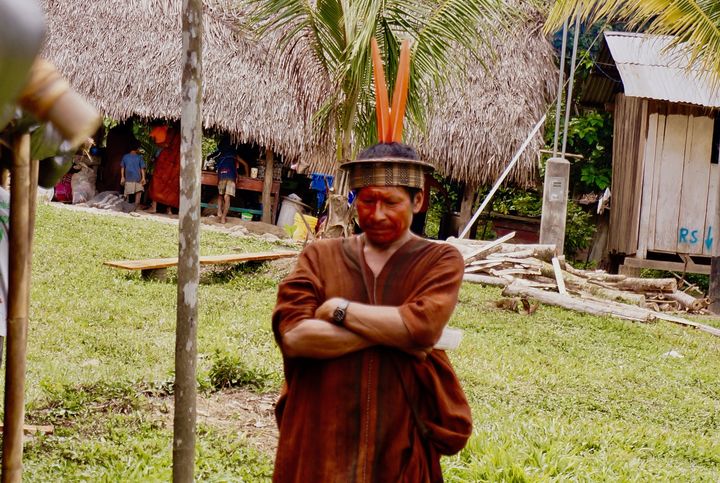
Ashaninka from the Paveni Community.
Sitting in a guest house kitchen in Lima, I anxiously waited to hear from my work colleague while Paku, an ugly Peruvian hairless dog, and I watched each other. He tends to scare all guests at the hotel, but at this point we have already established a friendship and I even find him cute.
I stared again and again at the walls full of posters with messages in bright colors, like LOVE HEALS by an artist from the jungle who through some kind of miracle is recognized in Lima, the capital. Peru is one of the most inequitable countries in Latin America and aside the questionable economic distribution, the striking social differences create an ever deeper wound in the country. Criticism, derogative talk and verbal abuse to the non-white are frequent occurrences.
The phone rang and it was Jesus, my co-worker, telling me he was in pain and had been diagnosed with kidney stones. I felt a rush of adrenaline in my veins and even felt elated, – I would be then the one taking his place and traveling to No Man's Land, in the jungle.
‘Joanna, you are “all terrain,” but this is more than that. Are you sure you want to go? He asked. ‘Sure!’ I answered.
‘I want you to feel better, but can’t lie to you, Jesus, I am somewhat happy you can’t go!’ We both laughed and hung up the phone. Before leaving, I was advised to buy an ajo macho (male garlic) and take it with me as protection. So, I did, not really understanding what garlic could do for me if I was in any danger.

In the search for an ajo macho (male garlic), believed by some groups to protect you from danger. Couldn’t it be a female garlic?
I was headed for VRAEM (Valleys of the Rivers Apurimac, Ene and Mantaro), the biggest source of cocaine in the world with coca plantations and laboratories spreading throughout the area. Peru surpasses Colombia as the world's largest cocaine exporter. That area however, is home to the Ashaninkas, a large indigenous community in the Amazon, which is scattered through the region in small groups. Oil companies, drug traffickers, and illegal logging all represent some threats to this community. I was here to witness a summit meeting of Ashaninka communities.
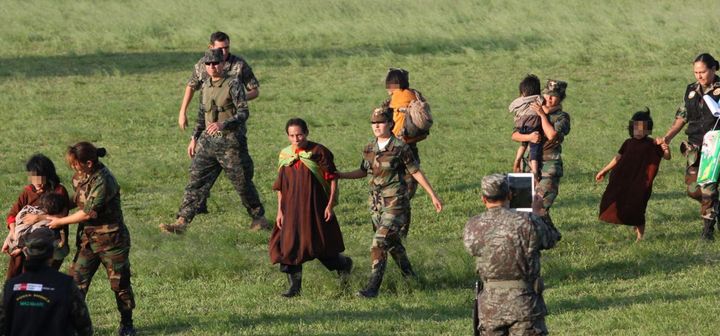
26 children (ages 1 to 14) and 13 adults are rescued from exploitation.
At the bus station, I bought my ticket to Satipo, a town in the jungle. I realized some people were looking at me strangely: ‘You're going by bus to the Jungle?’ someone asked me. It is understood, in this society, that only people of lower social status would do that and some other dilettante-playing cowboy or to save lives. None of this crossed my mind; I just considered it appropriate to reduce the costs of the trip for the NGO I was working for.
Nine hours after my journey by bus and a small motorcycle taxi began; I arrived at the hotel in Satipo where I waited for my contact to pick me up. The boy behind the front desk was counting each second aloud as if waiting for the time to pass. He gave me my key and I went to the last room of a dark hall. The room was not very clean and as I opened the heavy curtains, I saw young boys on motorcycle taxis, everywhere. The old TV had only one channel playing 80’s - style videos with Latin American Icons. I decided to leave the hotel and go for a walk. There was only one plaza surrounded by modest shops. I glanced at a pharmacy and it occurred to me to buy some medicine, as they probably wouldn’t ask me for a prescription. I was right. I found a small restaurant and ordered a coffee with milk. The order arrived in the form of a cup full of milk and on the side a small pitcher of brewed coffee. I did not understand very well, but did not ask. Back at the hotel, I asked the front desk guy if anyone had called for me. The moody boy told me that the phone was busy as he was talking and didn't know if anyone called.
I went downstairs repeatedly, but the boy was still on the phone, so I decided to tune my ear and pay attention to the sound of car engines. At the end, there were not too many cars, so I could recognize if a car approached. Around 3am I heard a car and it was my contact – a guy from Barcelona with his little son, who was going to take me to the last community of the Ashaninka tribes in the Rio Ene, the native community of Paveni. A hipster with a tough look in his eyes and short temper. We waited for the chata (a very rudimentary type of raft used in the Amazon) to reach the river bank. We had waited for a couple of hours and finally it had arrived. Also taking the chata, were a mestizo senior Peruvian lady who had worked in this region for many years and a mestizo guy from Peru who lived in Germany. During the ten hours navigating the river and its amazing views, we were stopped twice by the military. The old lady told me not to say much and not to be nervous.
One by one we had to leave the chata and answered the soldiers' questions. That was the first moment I felt the need to hold on to my ajo macho. Suddenly with nothing protecting us, in the middle of nowhere, surrounded by soldiers and feeling at their mercy, the ajo macho gained power and converted itself in my closest hope. After some suspicion, we were allowed to continue our journey.
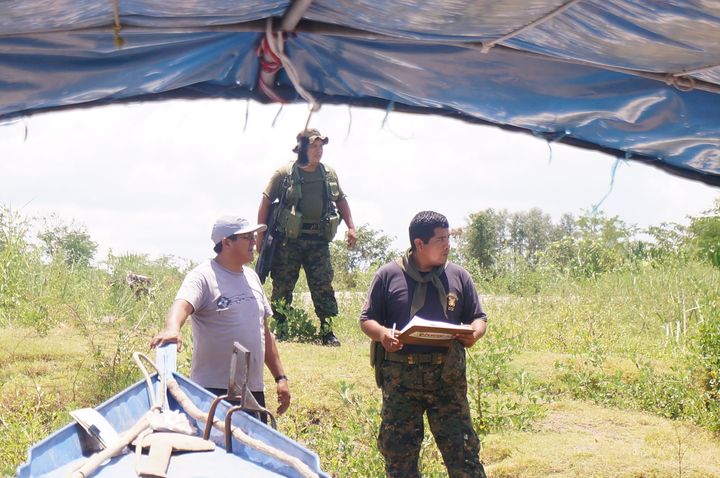
Soldiers’ checkpoint.
For the last leg of the journey, we climbed into the cargo area of a pick-up truck. The Spanish guy was an academic who came to this area to do some research 16 years ago and decided to stay. He lives with his partner, an Ashaninka woman, with their five children in big communal spaces with no doors, no walls and thatched roofs. He mentioned that in these communities it is not uncommon for young girls to be married shortly after their first menstruation. I couldn’t help, but to be puzzled when he answered to my only question, ‘Do you fear for your daughter?’ He said, ‘I try to keep a close eye on Anasha and her brother knows he has to look after her.’ The little boy showed a big warm smile while holding his mode of protection: a slingshot and small rocks he carried in a fabric bag across his chest.
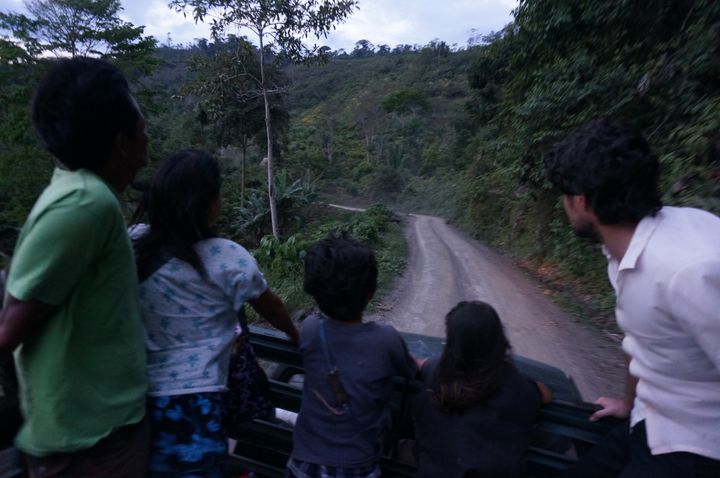
Driving through the coca plantations.
Standing in the crowded bed of the pick-up truck was difficult with all the dust and the deep curves of dirt road. My mind was fixed on the land, so green, so vast. For two hours we passed plantations of coca. My mind was not in the risk that we could be shot. My mind was on the poverty and the people who are victims of violence in an area plagued with drugs, military, and according to the government, the resurgence of a rebel group. Among the coca plantations, camouflaged men with rifles were vigilant to our truck. Malnourished children with empty eyes stared. Political propaganda and signs constantly warned ‘Do Not Enter.’ But there was no other way to get to the last communities of the Ashaninka of Rio Ene.
Finally the truck left us across a stream from the community. We crossed by foot and arrived to a place at the end of the world and to the glances of short women and men with suspicious looks. We all slept in two community rooms in hammocks and woke up at 4am to the sounds of the planes of the narcos. An hour later we would hear the sounds of the planes of the military seeking the narcos. Apparently, it was a day to day activity.
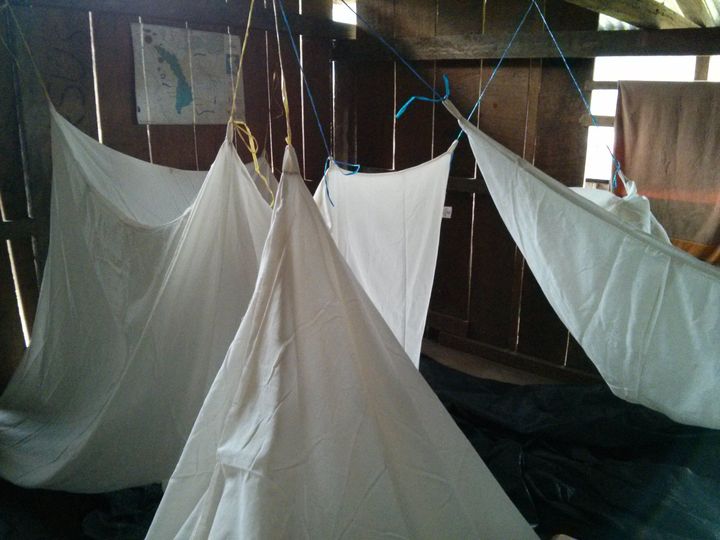
Sleeping arrangements at the communal rooms.
It was time to bathe in the river and while feeling the cold water, a shy and very quiet voice cautioned me to be careful, there are some “animals” that enter into the vagina and is very painful and the nearest health center is seven hours away. I did not touch the water again for the next three days. I spent my time among yuccas and extreme poverty as I witnessed the Ashaninka communities meeting with some local governments in their extraordinary summit, held by the Central Ashaninka del Rio Ene. This organization represents and advocates for the protection of the rights of the 17 communities that live in that river. There were men with faces painted in red, wearing feathers and long robes, some with woven palm crowns and women in their red-brown robes, sitting barefoot on the floor distant in their own thoughts. However, there was Ruth, an Ashaninka leader who advocates for the protection of the Ashaninka culture, education and human rights.
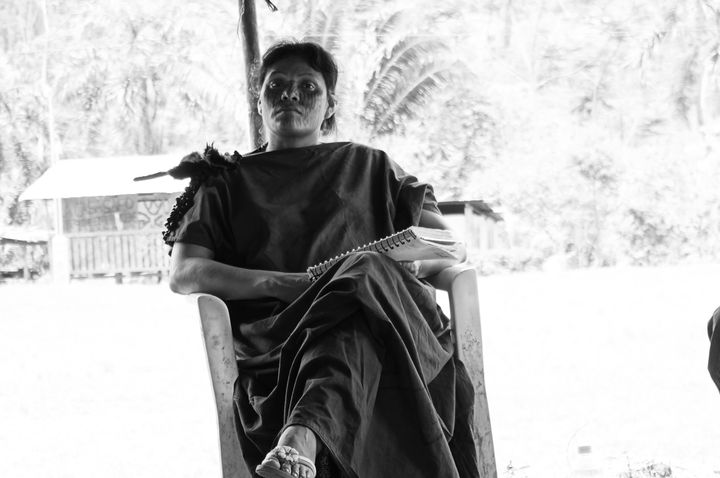
Ruth, Ashaninka leader who advocates for the tribes’ protection nationally and internationally.
At night, thanks to the Spanish guy, the women in the community invited me to their circle where a bowl of masato, an alcoholic beverage, was passed from hand to hand. It is made of yucca and locals chew and spit the masticated root for fermentation. The result ranges from social cohesion to also angry drunk men. However, at the same time yucca is their main source of carbohydrates.
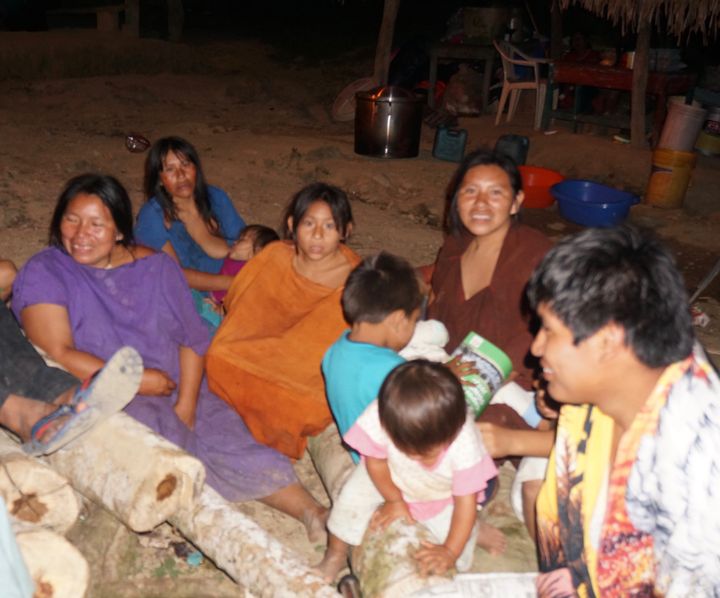
Circle of natives sharing Masato.
The last day arrived and the summit, with leaders of some of these communities, who had travelled days to gather to express the challenges they face in such an insecure area as the VRAEM, was over. It was time to head back to Lima to take my flight to New York City, but the waters had risen too high to cross on the other side where a pickup truck waited for us. To my surprise, the people on the other side managed to get a bulldozer and the driver invited me to jump into the blade, lifted it up, drove me across the water and dropped me on the other side to jump in the pickup truck. I turned around and waved in disbelief to the people in the community.
My heart ached, as I knew it was the last time I would be there and we ‘agents of change’ had given hope to hundreds of people who would not be served by any of us anytime soon, who would still not have access to health care, to food, to security and to the respect for the preservation of their culture. A place where 80 percent of the children suffer from malnutrition. In such a remote, violent and difficult geographical area to access, even the attempt of the government to deliver milk has failed. Here and there I came across some modest boxes containing milk burning under the sun and waiting to be picked up by some of these communities who have to travel miles to access a can of milk. With much effort probably the only thing they could access, if they were lucky enough to get into the blade of a bulldozer, was hundreds of hectares of coca. I held hard to my ajo macho and quietly thanked this garlic for the last three days of my life.
Exhausted, the other NGO workers and I arrived to Puerto Ocopa a town where we needed to wait for one of the few drivers in the area who mastered driving uphill through accumulation of mud and who reacts quickly to the thread of landslides. The water levels of the river had risen so high there was no chata working that day, as it was too dangerous. We were advised not to drive either as of most the trucks fell over, and there were many deaths. But still, for some reason I cannot remember anymore, we were going to be picked up by this guy in about 4 hours.

Things starting to look bad.
We separated, in this town of chaos and confusion dominated by men, to find a place to sleep. But all the “hotels,” which displayed large amounts of trash at their entrances were at full capacity. A lot of drunk men where ogling me. The senior lady and the Peruvian NGO worker realized it was better to be out of sight. Clearly as I looked around, we were the only two women there. According to some locals, here they were ‘all together’: The people working for the drug dealers and the militaries sharing drinks. Enemies by day and drinking buddies by night, and the people caught in between are the Ashaninka communities, I thought.

The hotel in Puerto Ocopa.
Finally, we found a place to sleep that night. Go to the second floor, they said. As we walked along the bare floors and around many chicks, we climbed the stairs and found tiny 1.5 by 2.0 meters rooms. They were made of plywood with handwritten numbers in each door in white chalk. We decided to open our tents in the middle of the floor and camp instead of using these rooms. We realized this was not a hotel, but a place where drunks were bringing the lost Ashaninka children and women for sexual pleasure.
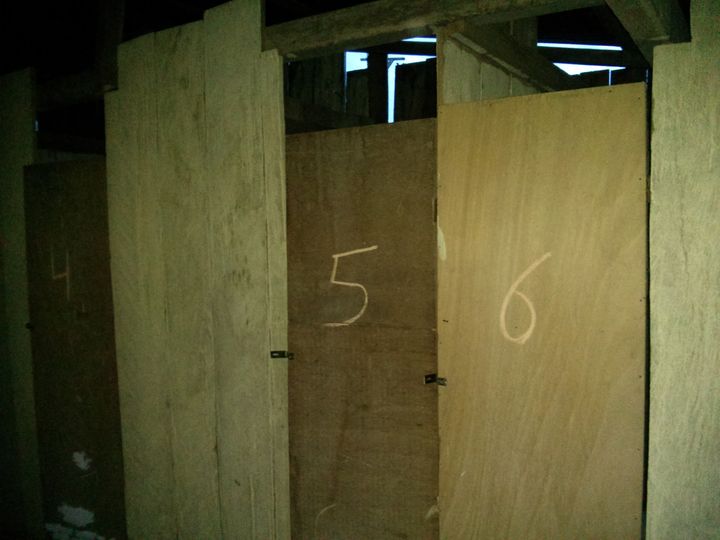
The hotel rooms where many Ashaninka children and women are exploited
I spent the next four hours awake staring at my ajo macho without surrendering; covering my ears while I whispered to myself Why is this happening? and dirty tears rolled down my cheeks nonstop. Before I knew it the driver was at the Port and the journey back started. We crossed many communities of Ashaninkas that were not as isolated as the ones we visited, stopping in each check control, making our way out. Ashaninka children carrying rifles stopped us to ask questions before letting us pass. The elders of the communities recognized the older lady that was with us during this journey although she had been teaching in the area about 20 years before. Thanks to this woman we were able to cross every check point, where tree trunks were used as crossing bars and which were manned by armed children.
There was a deadly silence in the car; I was convinced everyone thought we were going to die. Rocks were falling from cliffs, the mud began to accumulate and cars were sitting under water as the flood waters rose. As we passed overturned pickup trucks and people in need as they had an accident, our van slipped in the mud.
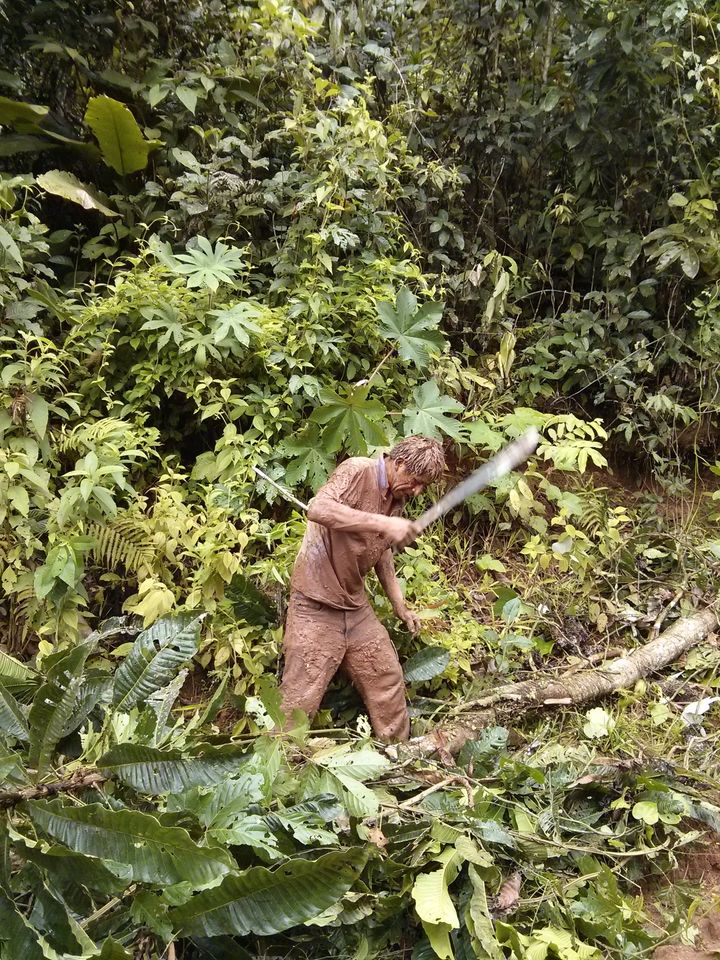
Man cutting tree trunks to help people hold on to them in the river’s rising water.
I still had in my mind the Ashaninka children that got lost or stolen from their communities and were in the hands of terror in Puerto Ocopa. At that moment I heard a voice, it was the driver: ‘Anyone has an ajo macho? We're going to need it.’ I opened my backpack, removed the garlic and threw it out the window because there is no magic, there is no garlic, male or female, there is no power that could change this situation. It has been a couple of years since this trip, but still every meal with garlic, to me it tastes of poverty and yucca.

Ashaninka Community.
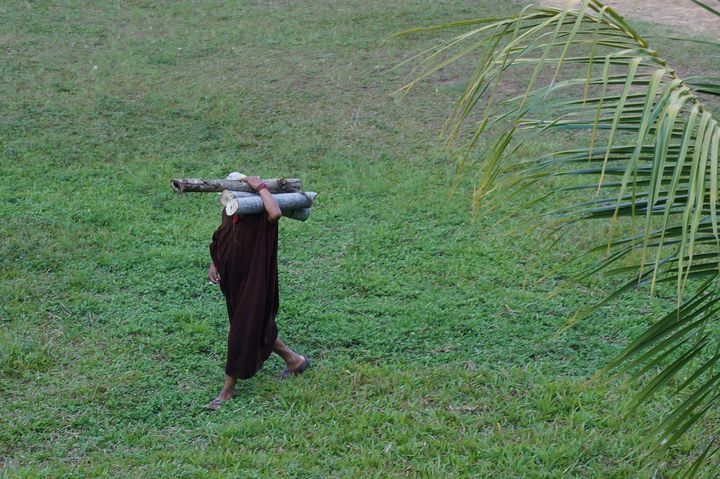
Ashaninka native.
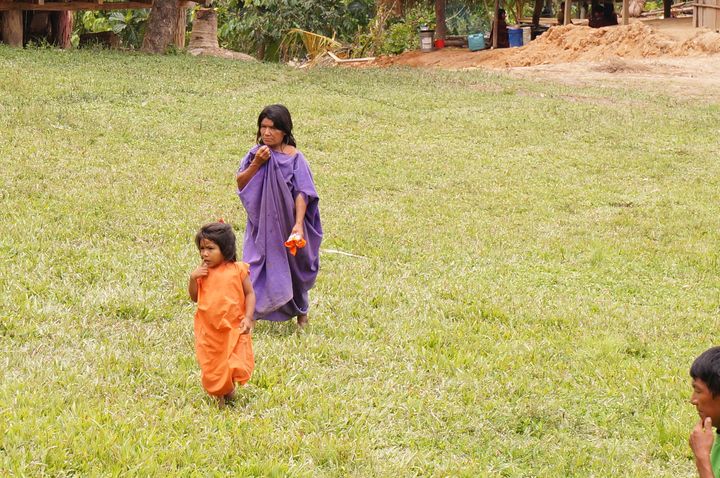
Ashaninka community members.
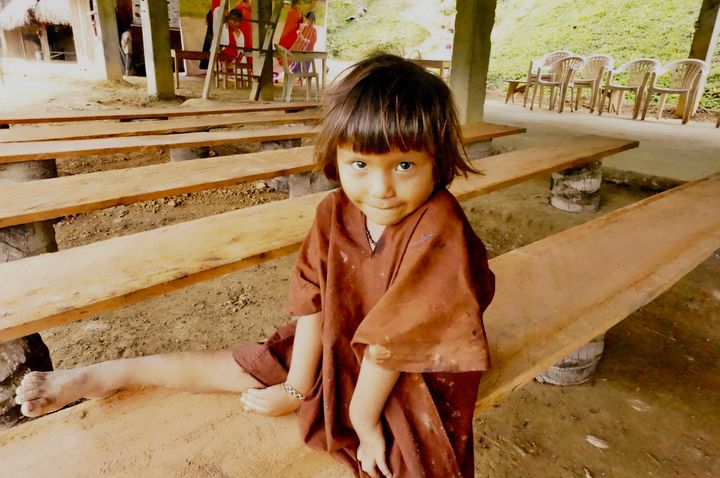
Ashaninka boy.
